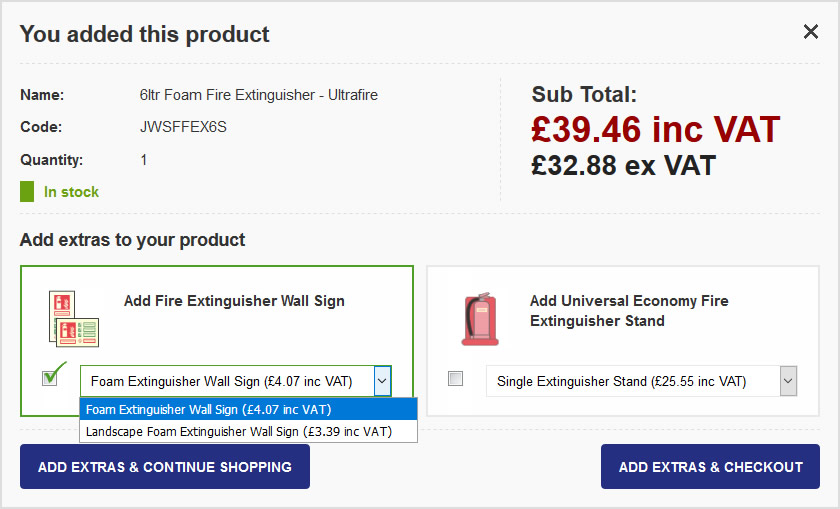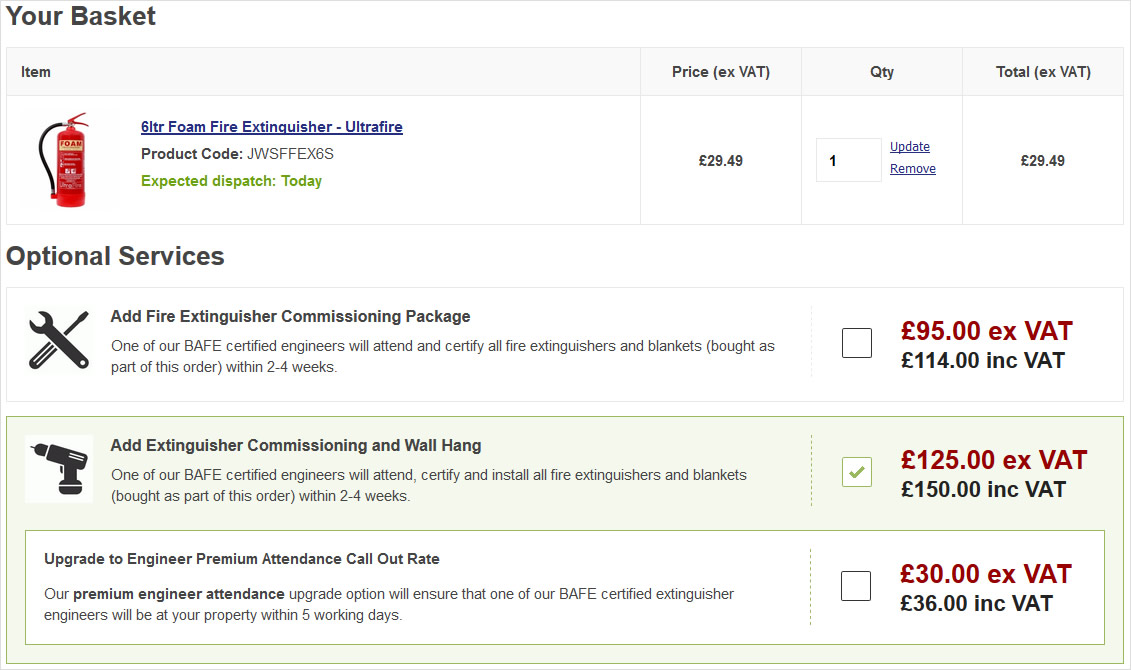Fire & Safety Solutions
CALL OUR TEAM NOW 0800 612 6537
Also FREE from UK mobiles
Free Delivery
on 100s of Products
Secure Payments
with our fast checkout
Online Support
Contact Us Now
30 Day Accounts
for Public Sector
5 Star Customer Feedback
What You Need to Know When Buying Fire Extinguishers
If you are replacing existing fire extinguishers it is easy to choose the correct fire extinguishers, as long as you are certain that nothing has changed in terms of fire risk since the last visit by a service engineer. Just ensure that you purchase extinguishers with the same type of extinguishing agent (powder, foam, CO2, water, de-ionised water mist etc) as are currently installed and that the rating of the new units at least matches the rating of the existing extinguishers. The physical size of the extinguishers does not matter, as long as the rating is met.
If you are purchasing extinguishers for new premises or if the building or its use has been altered, we would recommend that you ask Safelincs to carry out a site survey. We will send one of our BAFE certified fire extinguisher service engineers to carry out the site survey and to recommend types and locations of fire extinguishers required.
For any new installs we would strongly recommend that you consider the installation of service-free extinguishers to reduce the cost of ownership and to reduce the environmental impact. P50 service-free extinguishers only require a discharge and refill after ten years instead of the traditional 5 years. They also do not require a service engineer's visit for 10 years.
Which Type of Fire Extinguishers Do I Need?
Read our extinguisher types guide to learn about the different types of fire extinguishers and their suitability.
How Many Extinguishers Do I Need?
The basic requirement for fire extinguishers (Class A fire risks) in a building is the area of a building's floor space in square metres multiplied by 0.065. For example, if a single floor building is 20m x 10m you would have a floor area of 200 square metres. Multiply this by 0.065 and you arrive at the number 13. You now know that the fire extinguisher provision has to be 13A or higher. However, the actual minimum Class A provision per storey, according to BS 5306-8, is 2x A-rated extinguishers with a combined rating of at least 26A. Once you have determined what rating you require, you can select your extinguishers. If you are required to provide e.g. 26A, you would have to pick extinguishers with a total Class A rating of 26A or higher. An extinguisher's ratings are usually well advertised and vary from brand to brand.
Area of floor space (m²) x 0.065 = minimum requirement
Example: if your building is 600 square metres your minimum requirement for Class A fire extinguishers would be 39A (600 multiplied with 0.065 = 39). This could for example be covered by two 6ltr water fire extinguishers (with additives) with 21A rating each.
600 x 0.065 = 39
Combined total of at least 39A
On top of this you would need to account for any specific risks that your building contains by considering a few questions (risk assessment):
- Is there an area of your building that is used to store flammable liquids? For this you would need Class B rated extinguishers to cover the risk. The rules on how many Class B rated extinguishers are required are very complex; the minimums are governed by the exposed area of stored flammable liquids, the distance between storage containers, the total volume stored and the risk of spillage, with different requirements for each, with each having to be considered separately. As such we recommend, where flammable liquids are stored, that a site survey is carried out by a competent person to make sure that your coverage is both sufficient and legal.
- Where live electrical equipment is in use make sure that any water-based extinguishers are di-electrically tested. All of Safelincs' UltraFire foams and de-ionised water mists have been tested to this to exacting standard.
- Does the building have a kitchen area and if so what appliances are located there? For electrical appliances you may want to include a dry water mist and if you have a deep fat fryer you need to install a Class F wet chemical extinguisher.
Other Considerations when Buying Fire Extinguishers
Extinguishers installed on the same floor of a building or across all floors if it is a single occupancy, should all have a similar method of operation and should be of a similar design and standard. Therefore, EN3 extinguishers, which are red with a colour bar indicating the type of extinguisher, should not be mixed with older BS 5423 extinguishers, where the whole body is coloured to indicate the type of extinguisher. Extinguishers located on different floors should be located in a similar place to make it easier to locate them in an emergency.
Distance of Travel
The user should not have to travel more than 30m for Class A and C risks and 10m for Class B and F risks. Extinguishers should be located on escape routes, near to room exits, next to final exits, in corridors, etc.
The Regulatory Reform Order 2005 states that a person in control of a building must carry out a fire risk assessment, part of which is the provisioning of fire-fighting equipment. The person in control of the building might want to outsource this to a trained individual who can perform the risk assessment and indicate the correct provisioning for the building. Safelincs can carry out extinguisher site surveys, fire risk assessments and supply you with any of the necessary appliances.
The Buying Process
When you place an order for fire extinguishers you have various options available which will enable you to purchase optional extras such as signs, stands or certification and wall hanging.
When clicking on the Buy Now button, you will be presented with a pop-up giving you the option to add related items such as wall signs and stands - these are always tailored to the item you are ordering. When you are ready to place you order, click Checkout (or Add Extras & Checkout).

When you reach Your Basket you will see the Optional Services below your items. It is here that you can select the commissioning package you need. Ticking either of the boxes will open up a further option for Premium Attendance, which offers are quicker turnaround.

Extinguisher Only vs On-Site Certification
While you may order your extinguishers without commissioning, please note that extinguishers for business premises should be certified on-site in accordance with BS 5306.
After you have purchased your extinguishers we will deliver them to you and, if you have opted for a commissioning package, one of our BAFE registered engineers will contact you to arrange a suitable day on which to commission them on-site. This includes checking that the extinguishers were not damaged in transit, that they have been correctly installed and certifying that you have adequate extinguisher cover.
If you choose optional wall hanging the engineer will fit wall brackets and any signs that you have purchased.
Do I Need Identification Signs?
Under the EN 3 standard, the front label of a fire extinguisher now carries all the necessary information regarding what types of fire it can be used on and the procedure for actually using it. This means that the extinguisher itself is a fire extinguisher sign and a separate sign, in accordance to EN 3, might no longer be required. However, the official Fire Risk Assessment Guides state that suitable signs may be required to indicate the location of extinguishers and the latest British Standard for the provision of fire extinguishers (BS 5306-8) states that: 'The position and type of a fire extinguisher should be indicated on a sign so that, if the extinguisher is removed, this can be identified during a safety inspection, and a replacement ordered'.
What Needs to be Considered?
While additional fire extinguisher signs may formally not be required in your building, there are compelling reasons to include directional or photoluminescent signs in your provisioning. Imagine that you are trapped in a building during a fire, the rooms and corridors are slowly filling with smoke and reducing the available light and visibility. If your extinguisher, correctly installed on its bracket, is on the other side of a room full of desks and chairs, it is highly likely that you won't be able to see where it is. You may think that you will be okay as you have had fire drills and training and you know where the extinguishers are located, but in an emergency it is all too easy to get disorientated, for the thick choking smoke to obscure your vision and for panic to set in. In a situation such as this photoluminescent fire extinguisher signs installed at eye level are helpful. They are cost effective, require no power source (light is soaked up during the day and discharged when it is dark).
A sign must be installed if the extinguisher itself is not directly visible. In modern offices where everyone has their own cubicle it would be very difficult to locate the nearest fire extinguisher in an emergency. In this kind of installation it would be necessary to install some fire extinguisher location signs that are visible from anywhere in the room. Panoramic photoluminescent fire equipment location signs are ideal as they are viewable from every angle and are visible in low light.
Reviewed: 28/02/2023 (doc:22 V2.4). Our articles are reviewed regularly. However, any changes made to standards or legislation following the review date will not have been considered. Please note that we provide abridged, easy-to-understand guidance. To make detailed decisions about your fire safety provisions, you might require further advice or need to consult the full standards and legislation.




















